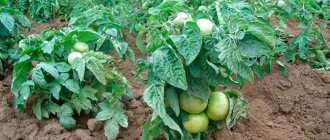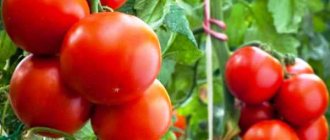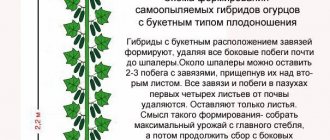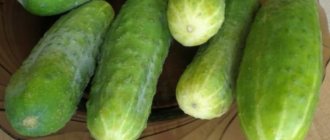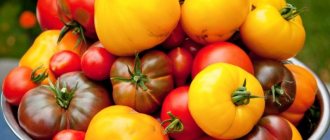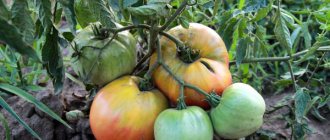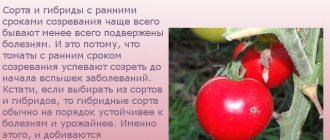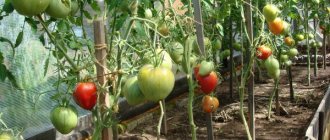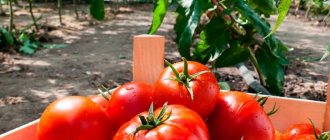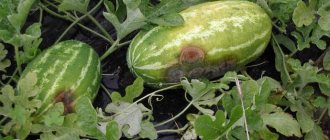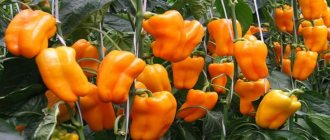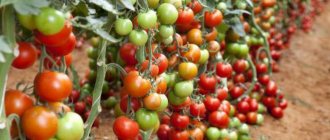Determinate varieties of tomatoes differ from indeterminate ones in that the plants themselves stop growing after the formation of 3 - 5 inflorescences. Although it is possible to form 6 inflorescences, this is less common. Gardeners call this process “topping”; this is when the last ovary is formed and the plant stops growing. Important
. The first ovary is formed after 5 - 7 leaves, and then inflorescences are obtained after 1 - 2 leaves. The height of the plant can be from 0.6 m to 1 m.
And yet, determinate varieties of tomatoes can be super-determinant and standard. Such varieties are usually low-growing (30 cm - 60 cm), and they do not need to be pinched or tied up. Here, leave 2 - 3 brushes, and then the process proceeds in the same way as with determinate tomatoes. By the way, in some cases, stepsoning is not avoided here either. It all depends on the growing conditions.
Typically, such varieties are grown in open ground or greenhouses. They don't need much space because they are short. Also, determinate varieties are most often early or mid-season, which can grow even in a short summer. Further in the article, we will consider the best varieties of determinant type and choose what we need. Go?
What is included in the concept of a determinate variety?
Having found out what determinate tomatoes are, every gardener will know whether they are worth growing or not. Let's take a closer look at what determinacy means and everything connected with this concept.
Determinant is translated as “determinant”. If this concept is applied to plants, then it means that the plant grows only to a certain height and will not stretch higher.
For example, determinate tomatoes stop growing when a flower cluster appears at the top. If you don't want to grow a lot of tomatoes, then determinants are the best choice. In addition to growth, these varieties are distinguished by the fact that they produce an earlier harvest.
If your goal is to get a huge tomato harvest, then you need to choose indeterminate varieties.
What differences should be taken into account when choosing a variety?
There are several different signs. The main difference is not the height of the bush, but how it develops when clusters with ovaries appear.
Indeterminate tomatoes will grow upward for a long time and produce fruit throughout the season. Determinate plants stop growing when a certain number of clusters with flowers are formed.
Determinate and indeterminate varieties also differ in the timing of seed sowing.
In the middle zone, sowing dates are as follows:
- indeterminate tomatoes - in early March;
- semi-determinant - in mid-March;
- determinate - sow at the end of March.
Turbojet
It went on sale in the 2022 season and has already gained enormous popularity among gardeners. The variety is super-determinate, very compact, about 40 cm high, covered with fruits. There is no need for stepsoning, since the fruits are formed on these very stepsons. The tomatoes are small, no more than 70 g, but in huge quantities on the bush, so it needs a garter. According to reviews from vegetable growers, when planting seedlings in March, the first tomatoes were harvested already in July, despite the fact that they were grown in the open air. The variety is stable and produces high yields even in cold summers. Recommended for cultivation in the regions of the middle zone and beyond the Urals. It is not recommended for cultivation in the southern regions, since the trunk is sparsely leafy and will not be able to protect the fruits from the scorching sun. A variety for universal use.
The main differences between determinate and indeterminate and other tomatoes
Determinate and indeterminate tomatoes can be distinguished by seeds, seedlings and mature bushes.
How are the seeds different?
Sometimes on packets of tomato seeds you can read: low-growing, medium-growing and tall-growing varieties. This definition will tell you little about the variety.
Among the indeterminates there are also short stature ones. And there are determinate tomatoes that have a tall stem. They are bred for growing in greenhouses.
When choosing seeds, you should pay attention to the inscription - is it a hybrid or a pure variety.
Better to buy a hybrid. Hybrids are more hardy, get sick less, rarely succumb to insect attacks, produce more fruit and ripen earlier.
The difference is in the seedlings
The main differences in tomatoes can be seen starting with the seedlings. Having examined the sprouts, we notice that the height of the cotyledon is different. In determinate varieties it will be only 1-2 centimeters, in indeterminate varieties the knee will stretch to 4-5 centimeters.
The age of seedlings for planting in a permanent place is also different. Determinate tomatoes are ready for planting in the ground 55–60 days after sowing the seeds. Non-determinant - only after 65–75 days.
The type of bush can also be determined by the seedlings. On the determinant, the brush with flowers will set when the 5th or 6th leaf appears on the bush; on the indeterminate, after 8-10.
Some determinate varieties can be planted directly into the ground, but such manipulation will not work with tall specimens.
Mature bushes differences
The different formation of the trunk is also a noticeable difference. The determinate plant has 2 or 3 leaves between the ovaries; a flower raceme is formed at the top of the stem to complete growth. Indeterminate types of bushes always grow only 3 leaves between the ovaries.
Advantages and disadvantages
When planting tomatoes outdoors, it is very important to know the tomato variety, since weather and regional conditions are not suitable for all varieties, some are grown exclusively in greenhouses.
Advantages of varietal tomatoes:
- Early and mid-term maturation.
- Short stature.
- Possibility of growing in the ground and in a greenhouse.
- Friendly fruiting.
- Wide range of varieties.
- Versatile use of fruits.
Disadvantages include frequent fertilization, the need to remove and install support poles, and average yield.
Indeterminate tomatoes are more fertile, unlimited cluster formation allows you to harvest gradually and in large quantities, and tomatoes can be harvested in heated rooms even in winter. A significant drawback is the difficulty of growing, or rather, proper care and formation of bushes. These varieties are grown in polycarbonate greenhouses, which provide excellent protection from wind and hail, but also perfectly transmit sunlight and maintain appropriate humidity and temperature.
After the seedlings have sprouted, begin to form the bush by equipping it with a support stand, removing shoots and, if necessary, pollinating the flowers by hand.
If all agronomic requirements are met (tying, pruning, fertilizing, mulching, irrigation), the yield will be 4 times higher than that of ordinary tomato bushes.
Types of determinate varieties and hybrids
The determinate tomato variety is divided into four types. The division is based on:
- bush growth,
- number of flower brushes,
- ripening time and
- productivity.
Division into types:
- semi-determinate,
- determinant,
- superdeterminant,
- super-superdeterminant.
Semi-determinate varieties
What does this look mean? It has mixed properties, so it is easy to confuse it with indeterminate species. Growing up to 2 meters, this variety or hybrid is convenient for growing where it is necessary to save planting area. Tied to a trellis, the bush will take up less space.
On the main stem, the first brush is formed after 7-8 leaves, and on the lateral branches - after 3-5 leaves. The next tassels appear after 2, and sometimes after 3 sheets. After the formation of 10-12 brushes, the bush stops growing upward.
High yield and excellent taste of the fruit make this species popular.
Semi-determinate hybrids or varieties are most suitable for greenhouses. Despite the wishes of the manufacturers not to tie them up, they need a tie-down. The weight of the fruit may cause the bushes to break.
Determinant
Determinate tomatoes, varieties of which are attracted not only by their names, but also by their characteristics, are frequent guests in the greenhouses of summer residents.
Many determinate varieties are also suitable for growing in open ground.
Determinate variety of tomatoes, what is it? The bushes of these tomatoes are not tall. The first ovary forms above the 6-7th leaf. Plants produce a harvest not early, but not too late, just when the early varieties have already reached the table.
The hybrid has a compact bush of low stature. After the brush appears on the top of the bush, it stops growing. The fruits are quite large, up to 150 g), very tasty. But they are not intended for long-term storage.
Superdeterminant
These plants are characterized by shorter growth, but early fruiting. Their first peduncle lies above the 4-5 leaf. The tomato does not need much time to grow these leaves, which is what determines its early ripening.
Tomatoes manage to produce a good harvest before the onset of unfavorable conditions. At the same time, they do not need gartering or pinching.
Superdeterminate varieties may differ from other determinants in their resistance to adverse conditions that occur in nature.
They grow well in open ground in the middle zone. The fruits have time to ripen before the onset of autumn rains and cold weather.
Supersuperdeterminant
Superdeterminants yield the harvest together and quickly. You can't expect any more tomatoes from them.
They also have a subspecies - super-superdeterminant. This tomato variety is distinguished by its ultra-earliness and low growth. The height of the stem can reach 45-60 cm.
The culture makes it possible to get the earliest harvest, before late blight begins. The first raceme appears above the 6th leaf, and then grows through 1 leaf or close to each other.
For greenhouse conditions
Early determinate varieties of tomatoes are quite profitable to grow in greenhouses in areas with low ambient temperatures for tomato development. Plants are usually formed into 2 shoots. In this case, the growing tip is pinched after the formation of several fruiting clusters. This creates favorable conditions for the full ripening of the crop. With the expenditure of a minimum area, the yield is 5-10 times greater in weight than that grown in open ground.
The best varieties of determinate early tomatoes.
Blagovest
An early maturing hybrid of determinate type is grown in glass greenhouses. The yield of one bush with a shoot height of 150-170 cm is 7-8 kg. The fruits are used universally.
Buddy
The hybrid is characterized by a yield of up to 15 kg per square meter of area. A low plant is formed into 1 shoot, which requires pinching the top and removing axillary shoots. Fruits weighing up to 100 g are tasty in salads and preserves. They have dense pulp and good transportation.
Shady Lady
The hybrid was bred by breeders from Holland. In a greenhouse, the yield is 7.5 kg per square meter. The bush grows up to 70 cm in height; pinching is required. There are 3-4 tomatoes in a fruit cluster, weighing 170-200 g.
Valentina
A typical variety for whole fruit canning. Tomatoes weighing up to 90 g are shaped like plums. When growing in a greenhouse, it is recommended to remove the shoots and tie the plant to a support. On a square meter of area, 6-7 plants are placed, the bush of which reaches a height of 60-70 cm. The yield is 12 kg.
Advantages
What are the advantages and disadvantages of determinate and indeterminate varieties?
The main advantage of indeterminate species is that even in a small area you can plant several bushes, and harvest the same as from a large garden bed.
Harvest in the amount of 14-16 kg of fruits per 1 sq. meter is considered very good.
Indeterminate tomatoes have other advantages:
- The fruits have a good taste, are juicy and fleshy.
- They are resistant to fungal diseases.
- Good growth conditions can be created for these hybrids thanks to vertical staking.
- Forming a bush and plucking stepsons is easier than with other species.
- Long-term fruiting is of great importance, which is the most important advantage.
Determinate tomato also has its advantages. Advantages: early fruit ripening, high yields. Good fruit taste.
Meaning of the term "determinant"
First of all, let’s find out what a determinate variety of tomatoes means. This term comes from the Latin word “determination,” which translates as “limit, limit.” Tomato varieties with this definition are self-limiting in growth. Plants of this variety set an average of 4-8 tassels and stop growing. The difference between indeterminate ones is that they have no growth restrictions and can have an unlimited number of brushes. Therefore, they need to pinch the top of their head.
Flaws
Each type has its own disadvantages. Indeterminate tomatoes need support and staking. When planted early in a greenhouse, the crop needs artificial lighting and heating. Early flowering of the crop requires such additional care.
Deterministic culture has its disadvantages:
- A determinate plant produces less yield because the bush is limited in growth.
- Tomatoes are very demanding of mineral fertilizers.
- Stepping should be carried out once every 10 days.
- Due to reduced immunity, people get sick more often.
From the above pros and cons, it is clear that you need to choose both types for planting. Determinate and indeterminate tomatoes will help you always have a harvest of delicious tomatoes.
You can also grow other varieties of tomatoes, for example, standard ones. These varieties are shaped like a small tree with a pronounced main trunk.
To understand what each name of a variety or hybrid means, just look at the picture.
Openwork F1
It is considered one of the best determinate tomato varieties for greenhouses. It belongs to the same variety as Bourgeois and has the same growing season. Grows up to 90 cm. It was bred specifically for growing in greenhouses in the northern regions of Russia. In the south it is grown outdoors. One of the main advantages of this variety is its high yield. It forms ovaries in bunches, each of which contains 5 fruits, and there are usually about 4 bunches on one branch. Tomato fruits are medium-sized, weighing about 280 g. Productivity from one m2 to 12 kg. A variety for universal use. Like any high-yielding plant, it needs organic and mineral fertilizing. Step-sonning is necessary.
The best determinate varieties of tomatoes
To choose the best determinate variety, you need to read the description of a whole list of varieties, and then choose the one you like best.
Even by the name you can evaluate the merits of each tomato variety.
Eagle beak
“Eagle Beak” can be called the most unpretentious and tasty among the mid-early ones.
The large size of raspberry tomatoes is attractive. The fruits can be stored for a very long time. They are also good because they ripen quickly during storage.
It is pollinated by bees, so it can be grown in an open garden. Due to its high growth, it produces a large harvest. Not afraid of cold weather.
Honey saved
Tall, mid-season, very reliable variety, with heart-shaped fruits. The fruits are fleshy and sweet. When ripe they are orange in color.
It must be tied to a support so that it does not break under the weight of the harvest. When grown in the garden, most of the crop ripens on the vine. The fruit produces delicious juice.
Max
Early ripening determinant with large dark red tasty tomatoes. Requires gartering and removal of stepsons.
Newbie
The mid-early variety is suitable for growing in the southern regions. The compact bush is strewn with orange fruits. Does not require breaking of stepsons and garters. Nematode resistant.
Bourgeois hybrid
The hybrid is tall, mid-season, shade-tolerant. Resistant to diseases. Not afraid of temperature changes. Produces a lot of medium-sized red tomatoes in any weather. Tomatoes can be stored for 2 or more months.
Early ripening yellow tomatoes
The agricultural technology of early yellow tomatoes of determinate varieties is practically no different from red ones. But the fruits themselves are useful for children and the elderly, since tomatoes are rich in vitamin C and contain a moderate amount of acid. The substance niacin found in the composition helps strengthen the walls of blood vessels.
Important! Yellow tomatoes have a sweeter, less sour taste.
Golden heart
The early determinate variety has a fairly high yield of 5 kg per bush. Large fruits up to 200 g, of medium weight, located on a cluster of 5-7 pieces. The plant requires gartering of each of the shoots, the maximum length of which does not exceed 1 m.
Golden eggs
The determinate tomato is distinguished by its miniature bush size. The length of the shoots is only 40 cm, but the yellow fruits grow up to 200 g. The plant does not require gartering or pinching. Resistant to major diseases. Early yield of the crop occurs before the mass destruction of tomatoes by late blight.
Golden Andromeda
A determinate plant with a height of 60-70 cm is formed. Bright orange fruits weighing from 100 g are rich in carotene. Up to 10 fruits ripen in a cluster, so a garter is required. Ripening begins 88-92 days after germination.
Yellow giant
This large-fruited variety also requires garter. Flat-round fruits reach a weight of 700 g on shoots up to 150 cm long. The determinate variety produces an early tomato harvest 100 days after emergence.
Golden bullet
The fruits of early determinate tomatoes are used for baby and dietary nutrition. Plum-shaped tomatoes contain a complex of vitamins, up to 3% sugar and 4% carotene. One cluster produces 6-8 fruits weighing up to 50 g each. It is most beneficial to eat tomatoes raw.
For open ground
Determinate varieties of tomatoes for open ground are resistant to temperature changes and diseases.
Low-growing tomatoes are most often planted in open beds so as not to provide support. Early varieties are preferred because they have time to ripen before the onset of bad weather.
Sanka
Among open ground varieties, Sanka is distinguished by its very early ripeness. It grows to a height of only 30-60 cm. The fruits are round, red, and do not crack. Fruits well even in cold cloudy summers.
Alpha
You can do without seedlings by planting Alpha seeds directly into the ground. In the south, the harvest is pleasing already at the beginning of summer, in the north - in the second ten days of July. The period from sowing seeds to ripening tomatoes is 85 days. Can be transported over long distances.
Explosion hybrid
Super determinate species, not suitable for greenhouses. Seeds can be sown directly into the ground, bypassing seedlings. Not afraid of sudden changes in temperature and even frost.
The tomato is an early ripening determinate.
The choice of variety for growing in open ground determines whether you achieve the desired result; climatic conditions are one of the important factors in growing a tasty tomato. The temperate climate allows you to enjoy early ripening tomatoes. Usually, analyzing weather conditions over several years, we can say that the second half of summer is more rainy. And dampness is a weather disadvantage, under which Phytophthora, a disease of fungal origin, can easily form, and the fungus spreads quite quickly. It is necessary to fight the disease at an early stage, invest all possible resources and effort, only such care can save your long-awaited harvest. You can, of course, solve the problem differently, for example, grow only early ripening varieties on your plot, before the period of mass late blight infections. But otherwise, in both cases, it is necessary not to forget about prevention methods; believe me, in 50% of cases, it will help save the harvest, and even prevent the appearance of a sore.
For greenhouses
To make better use of greenhouse space, determinate and indeterminate varieties of tomatoes can be grown in them.
If you grow indeterminate hybrids in a greenhouse, you need to shorten the tops of the bushes to stop them from growing. It is enough for them to grow up to 2 meters. If the greenhouse allows, then let them grow to the roof.
Due to their tall growth, they produce a large harvest of delicious tomatoes.
Determinate hybrids are less productive, but their fruits ripen much earlier. The choice of varieties for greenhouses is also very large. It's time to get to know the most popular of them.
Alsou
Alsou is one of the best types for greenhouses. The height of the bush is only 80 cm. It requires the formation of a bush into two or three branches. This is not a hybrid, so you can save the seeds for next season.
Early ripening, it will take 90 days from the moment the seeds are sown until the first tomatoes are harvested. Requires a garter. The fruits are sweet, without sourness, and can weigh 500 grams. From 1 sq. per meter of area, 8-9 kg of tomatoes are harvested.
Spring of the North hybrid
The determinate variety can be grown where summers are short and cool. Early ripening. Pink juicy fleshy fruits reach a weight of up to 350 grams.
Bush 60 cm high. Productivity up to 8 kg per 1 sq. m.
Pride of Siberia
The determinate bush “Pride of Siberia” grows up to 1.5 meters. Some fruits weigh 950 g, and the rest - 850 g. Up to 5 kg of red tomatoes can ripen on one bush.
Tomatoes ripen early. It takes 95 days from seedlings to ripened fruits. Planted on 1 sq. meter 4-5 bushes, you can collect up to 25 kg of ripe tomatoes.
Big Mama
Big Mama produces the first fruits 85–95 days after germination. The height of the plant is only 60 cm, the bush is strong and stable. Weight of tomatoes is 200–400 grams. Each fruit has soft, sweet flesh with sourness. Does not crack and is stored for a long time.
Productivity is high - up to 7–10 kg per 1 sq. meters. Not susceptible to fungal diseases.
F1 doll
A determinate hybrid, with a height of only 70 cm, produces a large yield of tomatoes, weighing up to 400 grams. Needs a garter. Productivity - up to 9 kg per 1 sq. meters.
The fruits are pink and round. The pulp is sweet, juicy, fleshy. Can be transported over long distances.
Indeterminate breeding variety of tomatoes
What does it mean - giant tomato? The indeterminate plant can reach 4 meters. Such a vine will not produce good fruit, so pruning and pinching are the most important points in growing indeterminate tomatoes.
They are pruned at a height of 2 meters, which makes it possible to obtain an excellent harvest.
Indeterminate tomato varieties have the following positive features:
- produce high yields in limited areas;
- resistant to many diseases;
- convenient fruit collection;
- extended fruiting period (until October).
Indeterminate tomatoes are also characterized by a number of disadvantages:
- due to a long growing season - greenhouse cultivation;
- periodic cutting of stepsons and formation into one stem;
- installation of strong supports;
- Fruit ripening occurs at a later date.
On a note. It is generally accepted that these are exceptionally tall plants, when their counterparts are short. This is not entirely true, and there are exceptions to any rule. Among the various varieties of determinate tomatoes, there are also quite large specimens.
Planting and care
If you want to get a quick harvest, then you need to leave a distance of at least 35-40 cm between determinate bushes. They ripen early and almost simultaneously, so they need a large distance between the bushes.
Many gardeners plant seedlings not in holes, but in trenches. It is believed that this makes maintenance and watering easier. As a result, you will not have to water under each bush, but directly into the trench. It is also more convenient to apply fertilizers in a trench. Yes, and loosening is much more convenient.
The soil in the garden bed should be fertile and light. After planting, the plants should be watered with warm, settled water. After watering, as a rule, potassium fertilizers must be applied once every 14 days.
Features of caring for determinate varieties
To get a good harvest, you should follow a number of recommendations:
- Watering the bush is carried out rarely, but with a large amount of liquid.
- When flower stalks appear, watering is carried out every three days.
- If the summer is very hot, you can increase watering to once every two days.
- The first fertilizing is carried out 14 days after planting the seedlings in the ground.
- The ideal option for maintaining the plant is to use Mullein and Nitrophosk, which are diluted in a precise ratio in water. If they are unavailable, you can use Superphosphate or Potassium Sulphide; they belong to mineral fertilizers.
- The second feeding is carried out after the flowering period is complete. At the second stage, it is better to use chicken manure or potassium sulfate.
- The third feeding is carried out when the tomatoes are fully ripening. The best option would be to use urea.
Attention! If you water the bushes too often or too rarely, they become tiny and crack.
It is better to grow indeterminate varieties in greenhouses
Stepsoning
The question of how to properly plant tomatoes of these types is quite acute. Even experienced gardeners cannot give an exact answer. It seems that pinching determinants is simply cutting off unnecessary shoots.
But it turns out that you can remove the stepsons only when they grow by 3-4 cm. If you are late, then you should not try to remove a large process. When it is removed, the result will be a deep wound that will slow down the development of the plant.
An indeterminate plant, due to its high growth, also has many unnecessary stepsons. They stop growing when the tomatoes on the bushes ripen. Therefore, it is necessary to remove the stepsons before the fruits ripen, so that the extra shoots do not take away their nutrition.
Stepchildren should be removed once a week. The leaves also need to be cut off, leaving a few leaves above the fruits that have already set.
In a greenhouse, pinching should be done more often than in an open garden bed. It is recommended to remove stepsons and excess inflorescences every 4-5 days.
